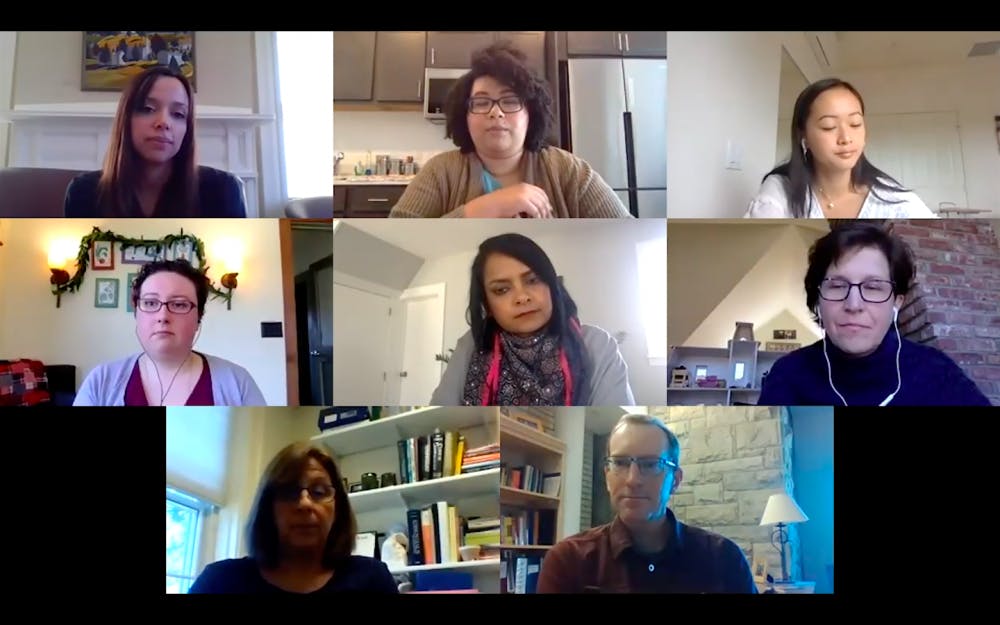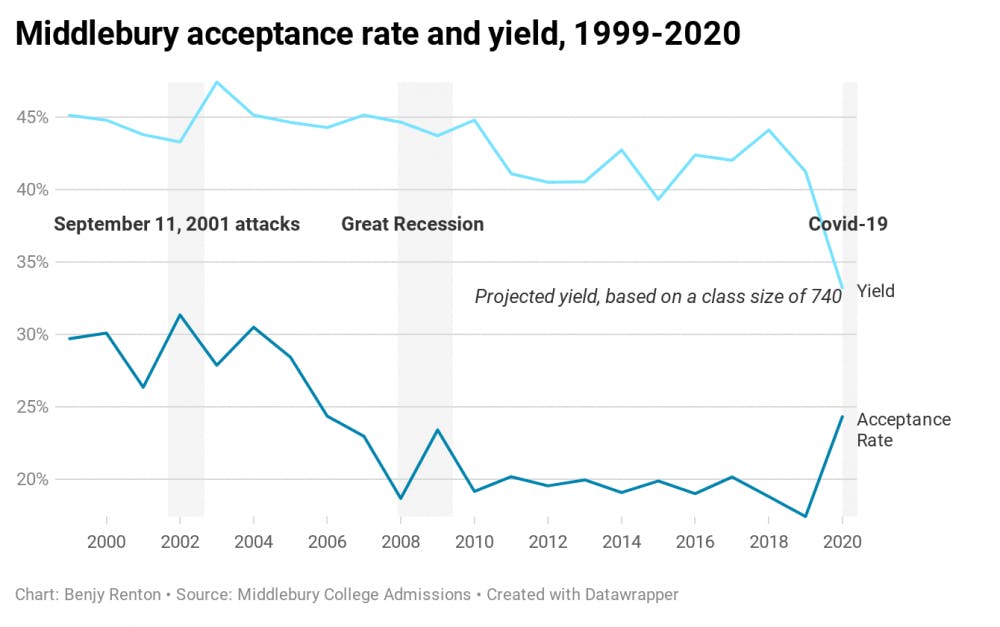Six days after most Middlebury students vacated campus to continue classes from home, the college admitted its biggest class of prospective students ever.
The acceptance letters received by 1,836 high school seniors this March, plus the 392 early decision acceptances doled out in December and February, were the first in a string of correspondences the college will send accepted students as it tries to virtually woo young adults who are making college decisions in one of the most unusual times in recent history. With campus completely closed to visitors, the Office of Admissions will now depend on webinars, social media posts, and its own students and alumni to replicate that feel-it-in-your-bones sense many students look for when they attend Preview Days in the spring.
Even with heightened virtual efforts, however, colleges around the world are facing Covid-19-related challenges that could lead students to either enroll in the fall as planned, or defer their admissions — a process experts refer to as “melt.” As a buffer, Middlebury admitted more students than usual to ensure it would reach its desired yield of 725–740 enrollees. The result is a pool of admittees that is nearly 700 students larger than last year’s and an acceptance rate that surpasses 20% for the first time in more than a decade.
Differing solutions to a potential yield problem across higher education suggest that navigating challenges posed by Covid-19 isn’t as black-and-white as just admitting more or fewer students on the front end. As Middlebury ramped up its acceptance rates, peer schools such as Colby and Bowdoin hit record-low rates. College admissions consultant Matthew Greene said that he anticipates many schools will take this latter approach, and will rely on their waitlists to address potential melt. Middlebury has not released its waitlist information for the class of 2024.
Greene said he thinks Middlebury’s method of accepting more students is “not a bad idea in the sense that students will be much more excited about a college if they’re admitted.” On the flipside, Greene said, the risk could be over enrolling the freshman class.
College Treasurer David Provost said the college is not necessarily trying to enroll more students, but is rather bracing itself for more pressure on financial aid and an uptick in deferrals, among other projections. Data is already beginning to support that more students are planning on taking time off before starting school next fall. Edmit, a Boston-based company that advises students on paying for college, conducted a survey of 100 college-bound students and found that one-third of respondents were considering taking a gap year. Another quarter of students said they were considering going to school closer to home, or in an area that is less affected by the virus.
“This wasn't a large sample size, but is consistent with dozens of conversations I've had with high school counselors, college-bound families and college admissions offices,” said Edmit co-founder and CEO Nick Ducoff.
Additionally, 10.5% of Middlebury’s admitted class is made up of international students, raising questions about access come fall. “Will travel rebound?” said Dean of Admissions Nicole Curvin. “Will they be able to get visas? Will countries open up so we’re able to get students to campus and to get them to orientation? We’re in really uncharted territory.”
There’s no historical precedent for the current crisis, but Greene pointed to the September 11 attacks and the 2008 financial crisis as other phenomena that affected students’ decisions about college on a macro level. In 2002, the college raised its acceptance rate from 26% to 31%, before dropping again the following year to 28%. In 2009, the college also saw a higher acceptance rate, but that was partly due to a decrease in applications by nearly 1,000 that year.
The applicant pool also decreased this year, which contributed to the higher acceptance rate for the class of 2024. The decline of about 585 applications from last year’s record-breaking numbers is unrelated to the coronavirus — regular decision applications were due on January 1, before China had even reported its first coronavirus-related deaths — but rather an ongoing demographic shift, according to Curvin, as fewer high school graduates come out of New England and more come out of the South and West.
“That was something we anticipated,” Curvin said. “We had a record high last year, and expected there would be a softening this year.”
Greene said he does not think Middlebury’s uncharacteristically high acceptance rate this year will hurt the college going forward.
“I think it’s going to be a blip, a small blip,” he said. “And I think that admissions rate is a small factor in the rankings game.”
Putting its best foot forward
Meanwhile, the college is inviting all hands on deck to show prospective students — including the 70% of admits who have never visited campus — why they should pick Middlebury. Instead of holding a virtual version of Preview Days, which was originally scheduled for early next week, Curvin said the office will try to maintain as much regular contact with students as possible, with daily emails and the help of Midd Kids from all over the world. Already, 450 current students have signed up to text admitted students about the college. Alumni who conduct admissions interviews will also reach out, and there will be scores of virtual panels and webinars on Zoom for those who want to know what it’s like to be a Feb or how the Center for Careers and Internships works.

Ursula Olender and her team at the Center for Careers and Internships gave a webinar last Friday.
In the absence of overnight stays and in-person tours, this sort of peer-to-peer outreach is key. Mariclare O’Neal, a high school guidance counselor in Chelmsford, Mass., said she thinks the biggest loss for students will be not getting a sense of the social environment on campus.
“I love accepted students days,” she said. “I think they tell you about the school. You get a vibe.”
The Office of Admissions was already beginning to build the groundwork for some of these online events and outreach initiatives. The Student Ambassador program for example, led by some members of the class of 2022 last fall, connected high schoolers from areas that fall outside the college’s usual purview with current Middlebury students who also live in those areas. And generally, as the number of applicants from New England has declined, the college has been boosting efforts to market itself online to those who might be more than a drive up Interstate-89 away.
Still, there was a mad dash in the days before decisions came out to create a revamped website for admitted students that includes a live chat feature, several FAQs videos on life at Middlebury that current students recorded from home and a schedule of webinars.
Andrew Cassel, the college’s new director of social media and content producing, said the Office of Admissions and Office of Communications created the website “over an intense four-and-a-half days.” He has been sharing informational posts about the college on its Instagram each day at noon and has turned to platforms like Facebook and TikTok to reach prospective students.
“Being able to engage with [newly admitted students] on TikTok helps differentiate Middlebury from other schools that may not have a TikTok presence,” Cassel said. He said there have been increases in the college’s Instagram and TikTok followings since the decisions were released.
https://www.tiktok.com/@middleburycollege/video/6805623602482892038
Senior Admissions Fellow Julia Sinton ’20.5 said she thinks one of Middlebury’s big selling points is its attractive campus. She noted that about half of the college’s visitors come in the summer. “So I think we're hoping to be open again in the summer and have a lot of visitors then,” she said.
Sinton and the other senior admissions fellows are still giving six information sessions a week via Zoom. Her info session yesterday saw an audience of 82 families, who asked about 50 questions using Zoom’s chat function, she said.

Faculty, staff and students participated in a March 27 webinar entitled "How Middlebury Supports Students." The webinar is one of six previous webinars currently available on the new admissions website.
Fellow Sandhya Sewnauth ’20 agreed that Middlebury’s rural charm is an important facet of its appeal.
“I do think that for students who are unfamiliar with rural environments and small towns, there is certainly an aura that you get once you are on campus that can only be felt in-person — I can recall this feeling when I visited Midd as a high school senior from New York City,” she said. “It was different from looking at pretty pictures in brochures, or YouTube videos of campus tours.”
Greene thinks Middlebury’s cloistered location will be a selling point this year, as coronavirus overwhelms crowded cities. But he also noted that it can be difficult to get there, sometimes requiring connecting flights through multiple airports.
“Clearly, safety and security are going to be top of mind for families,” he said.
Colleges all over the country are extending their deposit deadlines to June 1, but Middlebury is sticking to its May 1 date. Students who plan on deferring, meanwhile, must let the college know no later than June 1, according to the college’s website.
As one commenter wondered aloud on a College Confidential thread about the college’s uptick in admissions, it will be difficult to know until then how many students will actually matriculate in September. “It actually makes little sense, considering that they have had over-enrollment in the past and it didn't go well,” they said about the higher acceptance rate. “Alternatively, perhaps they know something that the other NESCACs don't.”
Editor's note: This story previously featured a photo from a webinar for incoming Febs. That picture has since been removed because one of the webinar's participants did not want her photo available on the internet.




